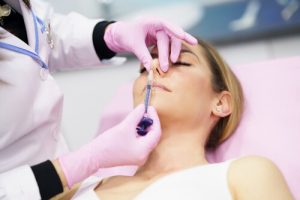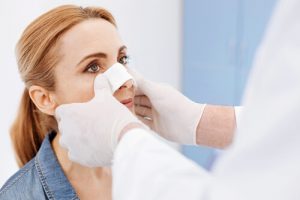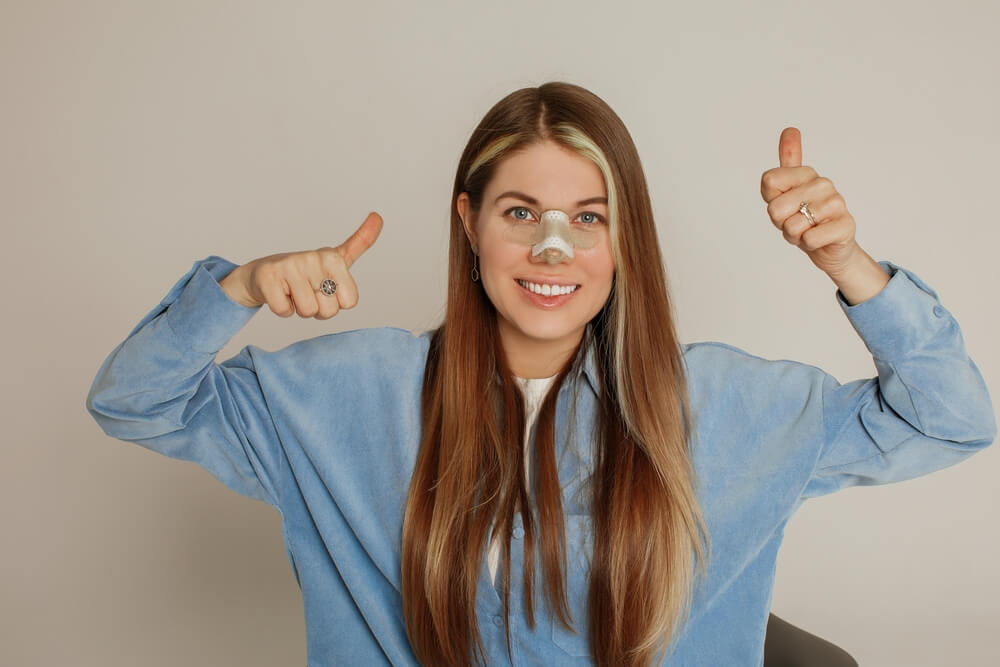Welcome to the intriguing world of the upturned nose, an enchanting facial feature that captivates our attention. This article delves into the aesthetic aspect of this unique trait, exploring its nuances, origins, and significance. Join us as we unlock the secrets behind the upturned nose, unravelling its allure and uncovering why it has become a sought-after characteristic in contemporary beauty standards.
Defining the Upturned Nose: Characteristics and Variations
The upturned nose, often a distinct facial feature, is characterised by its unique shape and position. This nose type, while common, can vary greatly among individuals and is often a point of focus in facial plastic surgery. Understanding its characteristics and variations is important for those considering cosmetic alterations to short noses, such as rhinoplasty.
Upturned Nose Characteristics:
- Nasal Tip Position: The defining feature of an upturned nose is the position of the nasal tip, which is angled upward more than usual, making the nostrils more prominent from a frontal view.
- Nasolabial Angle: The angle between the nasal tip and the upper lip, known as the nasolabial angle, is typically more acute in an upturned nose, contributing to its characteristic appearance.
- Variations in Degree: The degree of upturn can vary significantly among individuals. Some may have a slightly elevated tip, while others might have a more pronounced upturn, often called a ‘piggy nose.’
- Genetic and Ethnic Factors: The shape of an upturned nose can be influenced by genetic factors and is seen across various ethnicities, each having its range of typical nasal structures.
- Impact on Facial Harmony: An upturned nose can impact overall facial harmony. In some cases, it may enhance a person’s appearance, while in others, it might be perceived as out of balance with other facial features.
- Rhinoplasty Considerations: Rhinoplasty surgery offers various techniques for those seeking to correct an upturned nose. These can include reshaping the cartilage, adjusting the nasal bones, or using grafts to alter the tip’s position.
- Individualised Approach: Each nose job procedure for an upturned nose is highly individualised, considering the person’s overall facial structure, desired outcome, and functional aspects of the nose.
Genetic and Ethnic Influences on Nose Shape
The shape of one’s nose, including characteristics like an upturned tip, is significantly influenced by genetic and ethnic backgrounds. This diversity in nose shapes across different populations is a testament to the complex interplay between genetics and environmental factors in determining our physical features.
Factors Causing Upturned Nose Shape:
- Genetic Factors: Specific genes inherited from parents play a crucial role in determining the shape and size of the nose. These genetic factors can influence the overall structure, from the nostrils’ width to the nasal bridge’s height.
- Ethnic Variations: Different ethnic groups tend to have distinct nasal characteristics. For example, African and Asian populations often have wider nostrils and flatter nasal bridges, while European ethnicities typically exhibit narrower nostrils and higher bridges.
- Adaptation to Environment: Evolutionary biologists suggest that certain nose shapes may have developed as adaptations to environmental conditions. For instance, narrower nostrils are believed to have evolved in colder climates to warm the air before it enters the lungs.
- Impact on Surgical Procedures: Understanding ethnic differences is crucial in facial plastic surgery, particularly in procedures like rhinoplasty. Board-certified facial plastic surgeons must consider these variations to achieve results harmonious with the patient’s overall facial features while respecting their ethnic identity.
- Challenges in Defining ‘Ideal’ Nose Shape: The diversity in nose shapes across different ethnicities challenges the notion of a single ‘ideal’ nose shape. Beauty standards are subjective and vary significantly across cultures.
- Combination of Traits: Many individuals have a combination of traits due to their mixed heritage. This blending results in unique nose shapes that may not fit a single ethnic category.
- Personal and Cultural Identity: For many, the shape of their nose is closely tied to their cultural and personal identity. Alterations through surgery, if desired, are approached with sensitivity to maintain this connection.
Can Certain Diseases Cause Upturned Nose?
 While an upturned nose is often a genetic trait, certain medical conditions and diseases can influence its shape and structure. Understanding the relationship between specific health issues and changes in nasal appearance is important for medical professionals and patients to identify the underlying causes of facial feature alterations.
While an upturned nose is often a genetic trait, certain medical conditions and diseases can influence its shape and structure. Understanding the relationship between specific health issues and changes in nasal appearance is important for medical professionals and patients to identify the underlying causes of facial feature alterations.
Conditions Causing Upturned Nose:
- Congenital Conditions: Certain congenital conditions, such as Binder’s syndrome, affect nasal development, potentially resulting in an upturned nose. These conditions usually impact the nose’s bone and cartilage structure from birth.
- Rare Genetic Disorders: Rare genetic disorders can cause an upturned nose as part of their symptomatology. These conditions may involve other craniofacial abnormalities and are usually identified in early childhood.
- Trauma or Injury: Traumatic injuries to the face can alter the nose’s shape, sometimes causing it to turn upwards. Such changes are usually the result of accidents or injuries that impact the nasal cartilage or bones.
- Surgical Side Effects: In some cases, previous nasal surgeries, especially if not performed correctly, can result in an upturned nose. This is typically seen in patients undergoing multiple or poorly executed rhinoplasties.
- Diseases Affecting Cartilage: Diseases that affect cartilage, such as relapsing polychondritis, can lead to changes in the nasal structure, including an upturned appearance, due to the weakening or loss of cartilage support.
- Aging Process: The aging process can sometimes give the appearance of an upturned nose, as the structures supporting the nose may weaken and change over time.
- Autoimmune Conditions: Certain autoimmune disorders can impact facial features, including the nose. These conditions can cause inflammation and changes in connective tissues, potentially affecting the nose’s appearance.
Surgical Correction: Rhinoplasty Options for an Upturned Nose
Surgical correction through rhinoplasty offers a solution for those seeking surgical procedures to modify the appearance of an upturned nose. This procedure, tailored to individual needs and aesthetic goals, involves precise alterations to the nasal structure. Understanding the various rhinoplasty options for correcting an upturned nose is crucial for patients considering this surgical intervention.
Rhinoplasty Procedures for Upturned Nose:
- Assessment of Nasal Structure: The first step in surgical correction is a thorough assessment of the nasal structure, focusing on the nasal tip, septum, and overall balance with other facial features.
- Tip Rhinoplasty: For an upturned nose, tip rhinoplasty is often employed. This technique focuses on reshaping the nasal tip cartilage to achieve a more balanced angle relative to the lip and reduce the upturned appearance.
- Cartilage Grafting: In some cases, cartilage grafts, sourced from other parts of the patient’s body, add support and reshape the nasal tip, offering more control over the outcome.
- Nasal Septum Adjustment: Adjusting the nasal septum can also be part of the procedure, especially if the upturned appearance is due to a deviation or misalignment in the septum.
- Reducing Nostril Prominence: Surgical techniques may also include modifications to the nostrils to make them less prominent, a common trait in upturned noses.
- Customisation of the Procedure: Each rhinoplasty is customised, considering the patient’s unique facial structure and desired aesthetic outcome. The qualified surgeon will discuss the best approach to ensure the results are harmonious and natural-looking.
- Revision Rhinoplasty: In cases where patients are dissatisfied with previous rhinoplasty results or if complications have led to an upturned nose, revision rhinoplasty might be necessary to correct and refine the nasal shape.
Non-surgical Approaches to Modifying Nose Appearance
 Several non-surgical approaches are available for those seeking to modify the appearance of their nose without undergoing surgery. These techniques provide a less invasive alternative to surgical technique and traditional rhinoplasty, offering temporary solutions for altering the nose’s shape, size, and overall appearance.
Several non-surgical approaches are available for those seeking to modify the appearance of their nose without undergoing surgery. These techniques provide a less invasive alternative to surgical technique and traditional rhinoplasty, offering temporary solutions for altering the nose’s shape, size, and overall appearance.
Non-surgical Options:
- Dermal Fillers: Injectable fillers, such as hyaluronic acid, are commonly used to alter the nose’s contour. They can smooth out bumps, fill depressions, or even slightly lift the nasal tip. The effects are temporary, typically lasting several months to a year.
- Botox Injections: In some cases, Botox can be used to make subtle changes to the nose. For instance, it can help relax muscles around the nose that might pull the nasal tip upward, leading to a more desirable appearance.
- Non-surgical Nose Jobs: Often called ‘liquid rhinoplasty,’ this procedure involves injecting fillers to temporarily change the nose’s shape. These are quick upturned nose treatment options with no downtime, although the results are not permanent.
- Nasal Contouring with Makeup: Makeup techniques can be employed to create the illusion of a differently shaped nose. Contouring with darker shades along the sides and highlighting the bridge can visually alter the nose’s appearance.
- Nasal Strips: While primarily used for breathing issues, nasal strips can sometimes slightly lift the nasal tip or temporarily alter the nostrils’ shape.
- Lifestyle and Posture Changes: Improving posture can also impact the perceived shape of the nose. Holding the head higher can reduce the appearance of an upturned nose.
- 3D Printed Nose Enhancers: Emerging technologies like 3D printing have introduced nose-enhancing devices that can be worn temporarily to change the nose’s appearance without medical intervention.
How about changing your upturned nose? Remember, it’s all about what makes you feel best. Every nose is unique, just like you. Whether you love its distinct shape or opt for a little tweak, it’s your journey. Are you considering a change? It’s always smart to talk with experienced professionals. They’ll guide you towards a truly ‘you’ look and help you shine your brightest. Your upturned nose refers to your choice – embrace it your way!
Ready to explore your options for an upturned nose, or just curious about what’s possible? Don’t hesitate to reach out. Call us at (02) 8880 5116 to discuss your needs with Rhinoplasty Sydney Cost. Our team of experts is here to guide you through every step, from initial consultation to post-procedure care, ensuring you make an informed decision. Whether it’s for aesthetic enhancement or functional improvement, we’re committed to helping you achieve the results you desire. Call us today and take the first step towards the change you’ve been considering!
References
Upturned Nose: Causes, Treatment, and More
https://www.healthline.com/health/upturned-nose
Musculoskeletal Anomalies in Williams-Beuren Syndrome: An Orthopedic Perspective
https://pubmed.ncbi.nlm.nih.gov/25203590/
Williams Syndrome
https://my.clevelandclinic.org/health/diseases/15174-williams-syndrome
Williams Syndrome
https://www.mountsinai.org/health-library/diseases-conditions/williams-syndrome
Aesthetic Consideration in Cleft Lip Repair: Cupid Bow, Philtrum, and Primary Columella
https://e-aaps.org/journal/view.php?number=259

